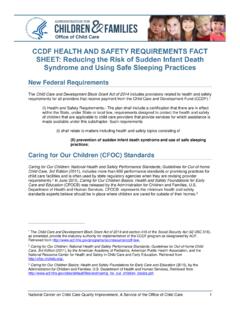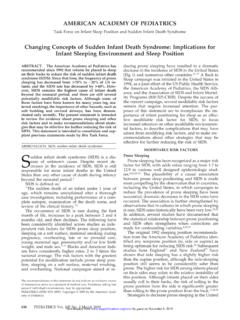Transcription of Sudden Infant Death Syndrome: An Update
1 Sudden Infant Death syndrome : An UpdatePolina Gelfer, MDAssistant professor of PediatricsObjectives for the Program sids definition & diagnosis Understanding sids risks sids risk reducing strategies Health care professionals rolePolina Gelfer, documented that she has no relevant financial relationships to disclose.~2,300~230 National MCH Center for Child Deaths ReviewSIDS -The major cause of Infant Death 1 12 mo/age3rdcause of Death in AnomaliesAccident/Adverse EffectsPneumonia/InfluenzaHomicide/Legal InterventionSepticemiaMeningitisRespirat ory DistressBronchitisMalignant NeoplasmsSIDS% of total Infant deaths28 - 364 days oldInfant Mortality StatisticsWhat defines sids sids is the unexpected Death of a previously healthy Infant under 1 year of age No cause of Death is determined by Death scene investigation Autopsy Review of baby s medical historyDeath Scene Investigation Interview of parents & witnesses Reenactment using dolls Examination of the beddingAutopsy A thorough postmortem examination Full skeletal survey Eye examination to r/o retinal hemorrhages Blood samples for toxicology and electrolytes levels Infant
2 S Medical History Previous nutritional and developmental abnormalities Unexpected sibling deaths History of domestic violence CPS and police involvementSudden Unexpected Infant Death (SUID) Any Sudden and unexpected Infant Death , explained or unexplained (including sids ) Suffocation, asphyxia, entrapment, infection, ingestion, metabolic diseases, cardiac arrhythmia, of SIDSThe child died in the night because she overlaid it (Bible, First Kings)History of sids Overlaying result of a neglectful mother Soranus, 2ndcentury first medical textbook: no co sleeping The term sids 1969 Seattle, 2nd international conference on causes of Sudden deaths in infants 1979 WHO: sids is an official cause of Death 1970sFederal funding released on sids research 1992 Back to Sleep recommendations 1994 Back to Sleep Campaign Back to Sleep Recommendations1992 Any nonprone position (side/supine) optimum for reducing SIDS2000 Back is best.
3 The risk of side position is less then prone2005 Only back sleep position during every sleep period; safe sleeping environmentAAP Statement, 2011 Supine position for sleep (no elevating the head of the crib) A firm sleep surface; no sleeping in sitting devices Room sharing without bed sharing; devices promoted as safe for bed sharing No redundant soft bedding and soft objects ( bumpers) Regular prenatal care Avoid smoke exposure Avoid alcohol/ illicit drug use Breastfeeding Avoid overheating Pacifier use Immunizations No commercial devices to reduce the risk of sids (wedges, ) Home monitors not a strategy to reduce sids Tummy time HC professionals to endorse recommendations Media and manufactures to follow safe sleep guidelines in their messaging Expand the national campaign sids Rate 1991 1992 1993 1994 1995 1996 1997 1998 1999 2000 2001 2002 2003 2004 2005 Rate per 1,000 InfantsTexas DSHS, VSU, 1990 2005 sids by Sleeping Place and by Sleeping Placement (n 102)
4 Texas Child Fatality Review Annual Report, 2010 Adult Risk Factors Changed since Back to Sleep Campaign (Trachtenberg, 2012)N= 568 (1991 2008)Before BTSA fter BTSP laced prone84%49%Side sleeping 133% (42% we found prone)Bed sharing19% (29%)38% (64%)Prematurity20%29%URTI47%25%# risk factorsThe same The sameSafe to Sleep Campaign, 2012 Public educational campaign lead by NICHHD Outreach activities in specific communities Relationship with community health workers and health care providers Tailored material for specific audience Safe to Sleep champion initiativeEpidemiology risk 2 4 months (91% deaths 1 6 mo/age) Seasonal trend: deaths in winter months (?overheating) Male infants (3:2 ratio) Preterm and low birth infants Racial and ethnic disparities American Indians/Alaska Native 112/100,000 Live Births Non Hispanic blacks 99/100,000 Non Hispanic whites 55/100,000 Hispanics 32/100,000 Asian/Pacific Islander 23/100,000 National Vital Statistics ReportSIDS Facts/EpidemiologyMaternal risk factors.
5 Teenage mother (< 20 y/o) Low educational level Low socioeconomic status Poor prenatal/postnatal care Smoking Use of illicit substances Strong association between Infant sleep position, sleep environment & sids The prone sleeping position is a prime factor associated with SIDST riple Risk ModelSIDSC ritical development periodModifiable EnvironmentalStressorsVulnerable infant0 12 monthsBrain stem abnormality, genetic factorsProne/sideSleep positionNicotineBed sharingOverheatingSoft beddingPossible Brain Stem Abnormalities The serotonergic (5 hydroxytryptamine [5 HT]) neurons control autonomic function and breathing sids may be associated with lower 5 HT and tryptophan hydroxylase Abnormal 5 HT neuron firing, synthesis, release, and clearanceDuncan 2010; Paterson 2006 Genetic Predisposition? Abnormal variant of gene coding for carnitine palmitoyltransferase in Alaska Natives Severe gene polymorphism may affect the immune response in the presence of a mild infectionBerkowitz, 2012 Sleep Position Back to Sleep for every sleep may alter autonomic control of CV system and cerebral oxygenation (Moon 2012) Babies sleep deeper; ability to arouse from sleep is decreased Side sleeping is not safe!
6 sids risks similar (Li 2003)or even higher (Hauck 2002; Fleming 1996; Mitchell 1997) Risks exceptionally high with the presence of infection (Helweg 1999) In newborns: side position does not promote clearance of amniotic fluid (AAP, 2011)Prone Position, GER, and Risk of Aspiration No increased risk of choking/aspiration, even in infants with GER (Malloy 2002; Tablizio 2007) Exception: Infant with upper airway disorders with impaired airway protective mechanisms Elevating HOB is ineffective and not recommended (Tobin et al 1997)AnatomyUnaccustomed Prone SleepingIncreases risk of sids , as much as 18 times (Mitchell 1999) Nonparental caregivers may use prone sleeping Less ability to lift head in tummy position Later development of upper body strength (Davis 1998)Barriers to Back Sleeping GER and fear of aspiration Delay of development Plagiocephaly Crib and Bedding Accessories Safety standards of the Consumer Product Safety Commission Firm mattress with fitted sheet, no extra soft subjects The strong association of sids and soft bedding (Hauck 2003) Prone sleeping + soft bedding = most hazardous (Kemp 1998.)
7 Flick 2001) No sleeping in sitting devicesBed SharingRoom sharing but not bed sharing!50% risk reduction (Blair 1999; Carpenter 2004) Infant < 3 mo Parent is smoker Fatigued caretaker Caregiver taking certain medications (antidepressants, pain meds, ) Not a parent Bed sharing with multiple persons Safe bed sharing devices Breastfeeding Reduces risk of sids (Ip, 2009; Vennemann 2009; Hauck 2011) The protective effect increases with exclusivity (Hauck 2011)Pacifiers Protective effect; mechanism is unclear (Hauck 2003) No forcing, no reinsertion Not to be hung around the neck; no stuffed toys attached For breastfed infants, delay using by 3 4 weeks No evidence that finger sucking is also protectiveRoom Ventilation and Fans Avoid overheating (Fleming 1990; Ponsonby 1992; Ponsonby 1993) Room comfortable for lightly clothed adult Prevent sweating, no over bundling ?
8 Use of fans decreased sids (Coleman 2008) no recommendationsSwaddling Evidence are unclear; no recommendations sleep, startling, soothe pain Better neuromuscular development, motor organization, less physiologic distress for preterms Tight swaddling may reduce functional lung capacity Loose swaddling head covering Immobilizations of arms and legs may reduce head covering with bedding (risk for sids ) Hyperthermia possible adverse effectBregje 2007 Swaddling TechniquesImmunizations Possible protective effect (Mitchell 1995; Jonville 2001; Fleming 2001) Infants should be seen for regular well child checks (AAP, 2011) sids and Prematurity Premature and LBW infants at high risk (Malloy 1995; Halloran 2006) VLBW infants are more likely to sleep nonsupine after NICU dc (Vernacchio 2003) Parental knowledge and acceptance are key Medical personnel plays critical roleBack to Sleep for NICUsNICU should implementand model safe sleeping practice as soon as the Infant is medically stable and significantly before the Infant s anticipating discharge, by 32 weeks PMAAAP, 2011 Apnea of Prematurity and SIDSA pnea/bradycardia events are not causally related to sids Extreme events are not happened at the time of night/early morning Asians had higher rate of extreme events AA Infant with lower number of events All events disappeared after 43 wks AGAH oppenbrouwers et al, 2008 CHIME studyUse Home Monitors Monitors may be of value for infants with CV/respiratory instability No evidence that monitoring sids (Ramanathan 2001.)
9 Hogman 1988) No evidence that infants at risks can be identified No over the counter monitors !Health Care Professionals Role Nurses/medical personnel play critical role in parental education (Vernacchio 2003; Colson 2002; Shaefer 2010) Staff education Practice the right way !Back to Sleep: Good Advise for Parents but Not for Hospitals? 94 hospitals survey (Hein 2001) 85 ( ) using back and side positions Nurses survey 42 64% always follow safe sleep recs. (Grazel 2010) 50% advise exclusive supine position after dc (Aris 2006)Right Messages from Media and Manufacturers051015202530354045 Sleeping supineFirm sleeping surfaceNo soft objects in bedParental complianceat homeQI Initiative: Back to Sleep to NICU Practice%Crib audit NICU, CHMH, 2010 Goal Back to sleep Firm sleeping surface No soft objects in bedWhy Develop a Hospital Based Program?
10 Captures 100% of the birthing population for education Point of intersection for all members of the health care team (obstetrician, pediatrician, nursing, and lactation) with family Nurses are critical role models It is efficient and cost effectiveOrganizational ChartHospital Based Safe Sleep ProgramProgram acceptanceCurriculum developmentProgram evaluationCommunity supportUnit guidelinesInitial educationMaintenance of educationFamily educationVolunteer fund Cribs for Kids Crib auditsPost dischargeparental surveyHospital administrationPhysiciansNursing staffOther staff (RT, Aides, PT, OT)3 phases: pre- during-, post-interventionInterventions/ Unit Guideline When is premature baby physiologically and clinically ready to start SSP? Does it contradict developmental care principles? Does position affect lung function?











